News
Wizardry, variety and firepower: Making sense of RCB’s signings
 ANALYSIS
ANALYSISHasaranga, Chameera, David and Garton all bring to the table traits that will bolster the Reds
Few franchises in the world know the value a replacement player can bring, as much as Royal Challengers Bangalore do. A decade ago, RCB signed Chris Gayle as an injury replacement for Dirk Nannes, and it turned out to be a move that ended up changing the landscape of the entire competition.
This time around they’ve not signed any player of Gayle’s caliber, but they’ve not messed around, either. The Reds have roped in five new faces, the highest tally among all franchises, and in those five are a few names that would walk into the starting XI of most sides.
We know Wanindu Hasaranga, Dushmantha Chameera, Tim David, George Garton and Akash Deep will all be wearing the Red & Gold jersey for the remainder of IPL 2021, but why did RCB sign them? We explore that in detail.
Dushmantha Chameera
A potential death-overs savior
After Harshal Patel’s remarkable five-wicket haul on the opening day of the season, there was a train of thought that RCB’s woes at the death were finally solved. The right-armer backed it up with another stunning showing against SRH, and then once again he and Siraj produced a death-bowling masterclass against KKR. It looked like RCB had gotten rid of their Achilles Heel.
Except, as it turned out, they didn’t. Once RCB shifted venues, from the slow and low Chennai pitches to the flat Wankhede and Motera wickets, old problems resurfaced. In Wankhede and Motera, the RCB seamers conceded runs at an ER of 12.3 and 12.4 respectively, a far cry from the 6.9 they managed in Chennai.

Both Patel and Kyle Jamieson leaked at over 13 RPO in those two venues, with Siraj turning out to be the only bowler to concede lower than 10 RPO. So bad were the RCB seamers at the death in those two venues that, when the IPL got suspended, RCB pacers’ ER at the death of 10.3 proved to be the third worst in the competition.
The Chameera signing will go a long way in helping them address this issue.
In six T20Is this year, the 29-year-old has maintained an astonishing ER of 6.2, striking once every 8.7 balls. No seamer to have bowled 10 or more overs at the death has been more economical. Against England and India, Chameera maintained an ER of 3.2 and 5.5 respectively, conceding just one boundary across 8.1 overs.
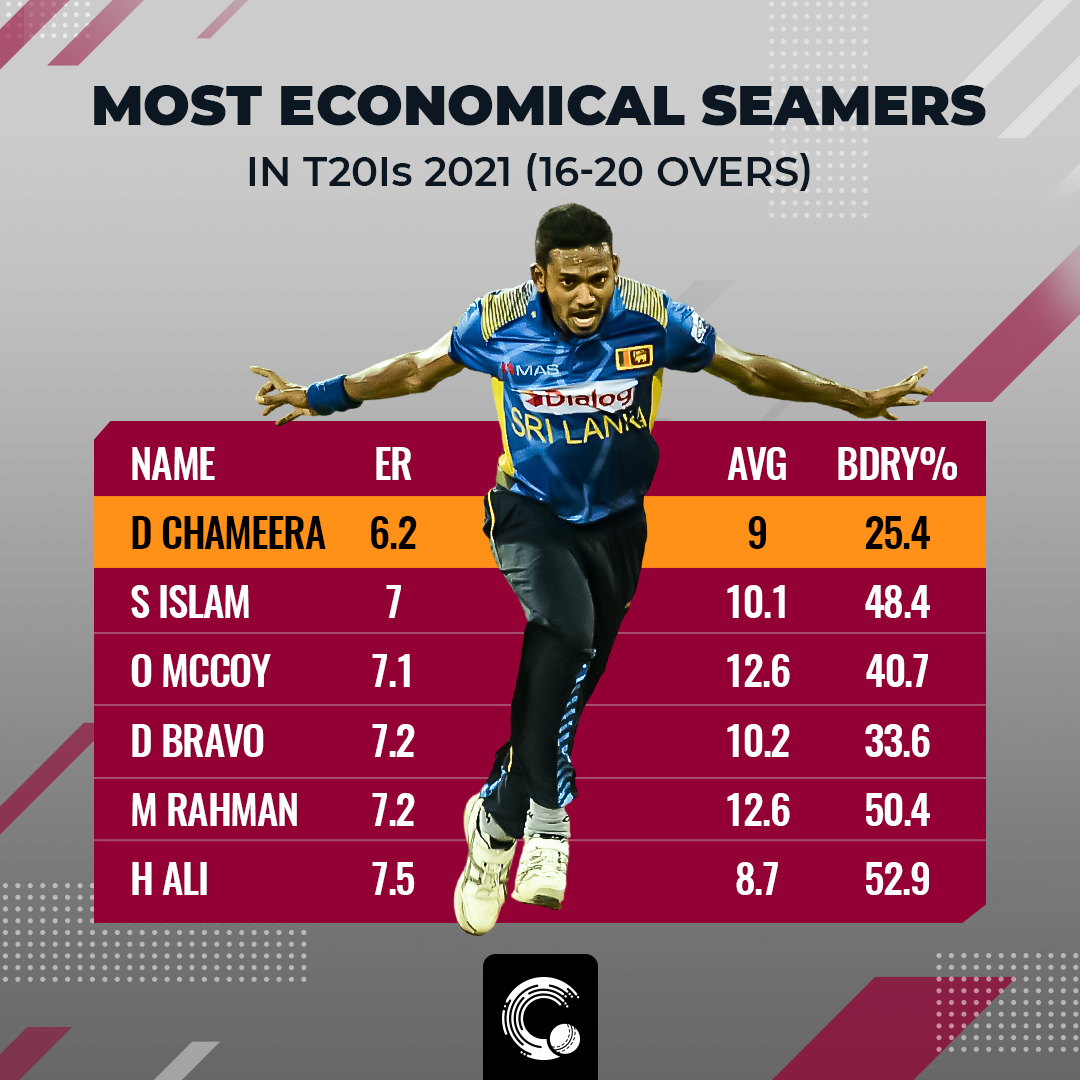
This year, Chameera has choked the batsmen by making great use of his pace, firing in the deliveries full. 52.45% of the deliveries he’s bowled at the death in 2021 have been shorter than 6 meters.
In conditions in UAE where wickets will be flat and pace will be requisite for success, particularly at the death, Chameera will be a handful and will bolster the RCB attack.
A support system for Siraj
Apart from being a weapon at the death, Chameera could also be the aggressive partner Siraj needs. With Harshal Patel struggling outside of Chennai, and with Jamieson (7 wickets at ER 9.2) having an ordinary season overall, the RCB pace attack, at times, looked like it was being carried by Siraj. Chameera’s inclusion, therefore, should prove to be a shot in the arm. It is something that RCB are also desperately in need of, with Navdeep Saini’s impact waning away.
Chameera is not just pacy, but also a leader who has turned into Sri Lanka’s go-to man. At the time of writing, no bowler has taken more ODI wickets this calendar year than Chameera (20), and, among full members, only Mustafizur Rahman has taken more T20I wickets this year at a better economy rate.
In short, the 29-year-old simply is a welcome addition to this RCB side.
Wanindu Hasaranga
An upgrade on Adam Zampa - or more?
Wanindu Hasaranga getting an IPL deal became a certainty after his stunning showing against India - 7 wickets at ER 5.58 - and RCB ended up beating every other team to his signature. Hasaranga might only be a ‘replacement’, but there is a case to be made that he, in fact, is an upgrade on the man he replaced, Adam Zampa.
Thus far this year, Tabraiz Shamsi (25 wickets) is the only spinner to have taken more T20I wickets than Hasaranga (19). But among spinners who have taken 12 or more wickets, nobody has a better economy rate than the Sri Lankan’s 5.3. It is more than 2 runs better than what Zampa (7.9) has managed this year.
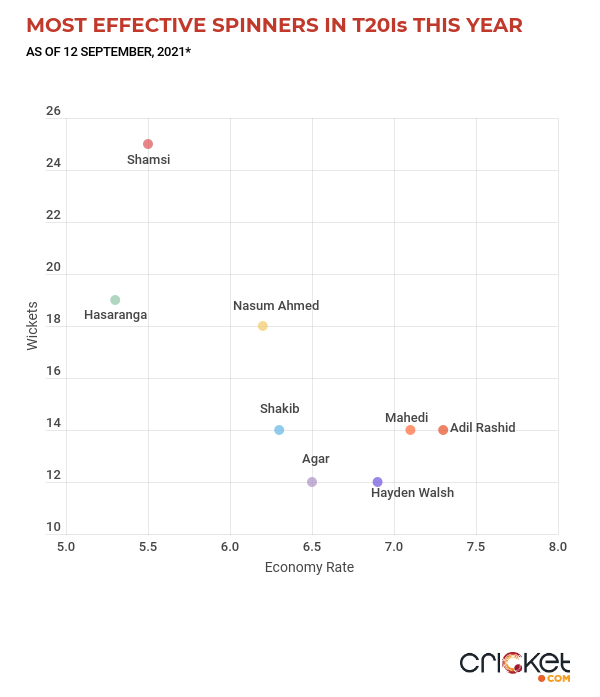 But could there be more to Hasaranga’s signing? Did RCB sign him not just as a Zampa replacement, but as someone who could even push Yuzvendra Chahal?
But could there be more to Hasaranga’s signing? Did RCB sign him not just as a Zampa replacement, but as someone who could even push Yuzvendra Chahal?
The numbers are certainly interesting. In the first half of IPL 2021, among leg-spinners who bowled more than 20 overs, no one had a worse average (47.5) and economy rate (8.3) as Chahal. His SR of 34.5 was also the worst among all leggies who sent in more than 20 overs.
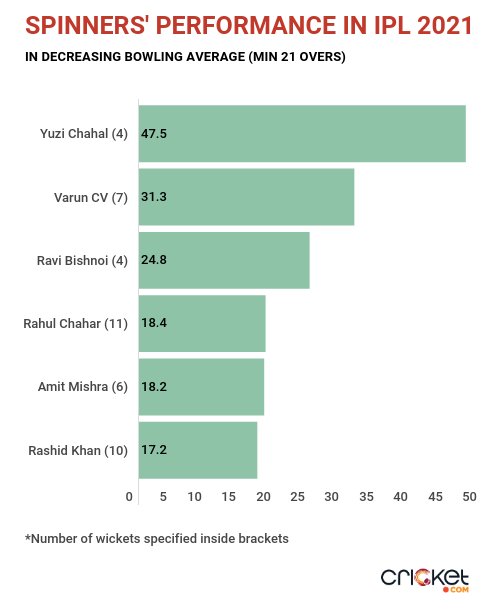 Chahal was also not particularly great in the middle overs (7-15), averaging 33, conceding runs at 7.8 and having a boundary percentage of 60.6%, the worst among all leggies who bowled more than 10 overs.
Chahal was also not particularly great in the middle overs (7-15), averaging 33, conceding runs at 7.8 and having a boundary percentage of 60.6%, the worst among all leggies who bowled more than 10 overs.
In comparison, Hasaranga, in the middle overs in T20Is this year, has averaged 12.4, has conceded just 5 runs per over on average and has a boundary percentage of 32.4%.
So while he is technically a Zampa replacement, Hesson could very well have roped in Hasaranga with the thought that he could maybe even usurp Chahal.
ALSO READ: Where does Wanindu Hasaranga fit into RCB’s scheme of things?
Could fill in for Sundar too
And let us not forget that Hasaranga is someone who is more than capable with the bat too. RCB, in the first half of IPL 2021, many a time promoted Sundar up the order, but with the off-spinner now injured, it might open the door for a potential Hasaranga promotion.
The 24-year-old’s T20I numbers might look ordinary, but in the 2020 edition of the Lanka Premier League (LPL), he showed just how dangerous he could be. There, representing Jaffna Stallions, Hasaranga struck 127 runs at a SR of 160.75. He has also shown his potential with the bat in ODI cricket, having struck 348 runs at an average of 34.80 and SR of 123.84 whilst batting at No.8.
Someone often under-utilized with the bat, RCB could fully tap into Hasaranga’s batting potential.
Tim David
A game-changer for the batting unit
RCB had an exceptional time in the first leg of IPL 2021, winning 5 of their 7 games, but something that stood out was how ludicrously their batting was dependent on 4 players. Kohli, Padikkal, Maxwell and De Villiers accounted for an astonishing 76.7% of all runs scored by the team, and despite a plethora of experiments, they simply could not get anyone else to score a run.
This is precisely why David’s signing is a game changer.
We know David is a monstrous six-hitter. In his T20 career he strikes at almost 153, and he hits nearly 1.35 sixes per game on average. But it’s not his six-hitting that is going to make a difference for the team. RCB already have de Villiers and Maxwell for that, and their death overs SR of 172 is already the third-best in the league. However, the assurance David brings could have a positive domino effect on the whole batting unit.
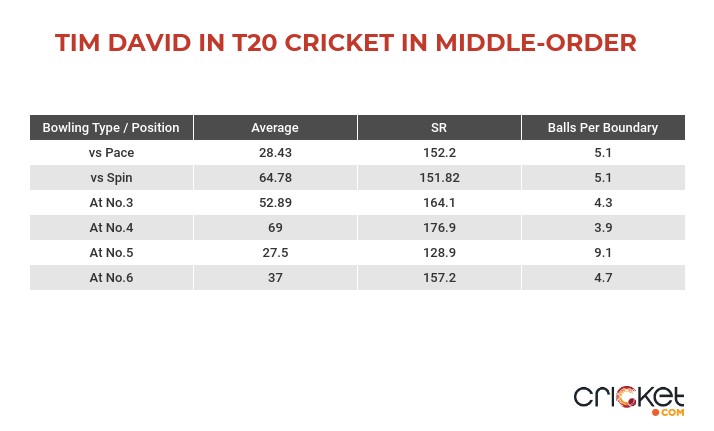
RCB held Maxwell back at No.4 in the first leg, partly to ‘lengthen’ the batting unit and partly to ensure they had himself and De Villiers at the crease towards the fag end of innings to give the side the final flourish. It worked in a few games at the start, but with time, the constant failings of Sundar/Ahmed/Patidar at No.3 started piling pressure on the middle-order.
ALSO READ: IPL New Arrivals: Understanding Tim David
David’s arrival gives RCB the option to bat Maxwell at No.3, knowing that they have someone else as potent as him who can go berserk towards the end - the Singapore batsman’s SR of 170 in overs 16-20 is 4 better than Maxwell’s figures in the IPL in the same phase. This could prove to be crucial as Maxwell’s averages 34 whilst batting at No.3 in the IPL, his highest tally for any position.
Then there’s also the option of batting David, himself, at No.3. The 25-year-old is quite a versatile batsman, having batted everywhere between 3 and 7, and so as someone who averages 53 and strikes at 164.1 while batting at No.3, David could prove to be handy walking-in after the openers.
The Singapore batsman not just gives the side options, but also brings in a kind of assurance Dan Christian was never able to do.
George Garton
A signing that completes RCB’s pace attack
Not since Tymal Mills have RCB had an out-and-out left-arm seamer who can intimidate batsmen with sheer pace, so Garton, in many ways, is a welcome addition to this Bangalore side. He replaces another left-arm seamer Daniel Sams, who really did not live up to expectations.
A player who was agonizingly close to being capped by England not too long ago, Garton is a complete package. He can touch the 90 mph with relative ease, has plenty of variations in his arsenal and is also someone who excels in all three phases. He is, in particular, extremely effective in the powerplay, where he concedes runs at an ER of 7.4 and bowls almost 50% dot balls.
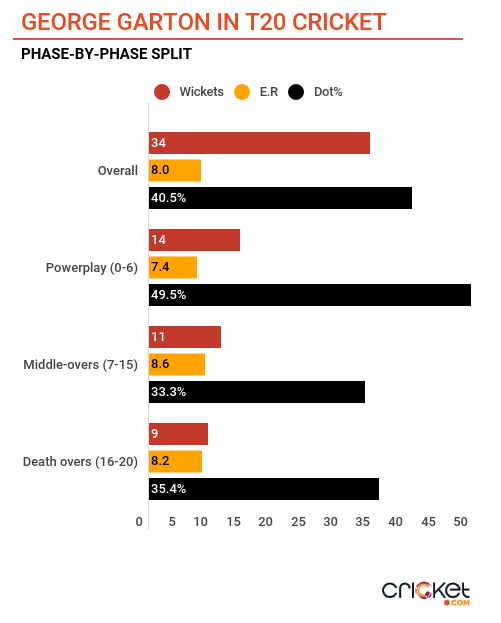
What he will add to this RCB bowling unit is variety. RCB, post Sams’ withdrawal, were left with only right-arm seamers exclusively, but Garton’s addition changes everything. It is also worth noting that he is an inherently different package than both Sams and Udana, who were swing bowlers reliant on slower balls.
ALSO READ: IPL New Arrivals: George Garton
Why Garton’s addition is crucial because, at a time where match-ups have more importance than ever, it is pretty handy to have a left-arm pacer, let alone of Garton’s quality.
In the first leg of IPL 2021, for instance, batsmen only struck at 130.6 against left-arm seamers in comparison to 140.08 against right-arm bowlers. Again, in the first half of IPL 2021, a team like SRH only averaged 21.3 against left-arm seamers. Thereby, Garton’s addition adds a whole new dimension to RCB’s pace attack.
Whether the 24-year-old will be consistently competing for a spot in the first XI remains to be seen, but his signing leaves Kohli spoilt for choices with regards to pacers.
Akash Deep
A curious signing in every way, Akash Deep will add more depth to RCB’s Indian pace contingent, if nothing else. Signed as a replacement for Washington Sundar, Akash Deep is neither a spinner nor a handy batsman, but the 24-year-old, a metronomic seamer who uses his height to his advantage, could be an out-of-the-box option with the new ball for the Reds.
However, with RCB already boasting a rich vein of depth and talent in the pace department, all signs point towards Akash Deep being a luxury squad signing to cover up for the worst-case scenario, rather than someone who will be competing for a spot in the starting XI.
Note: All numbers and statistics in the article are as of September 12, 2021